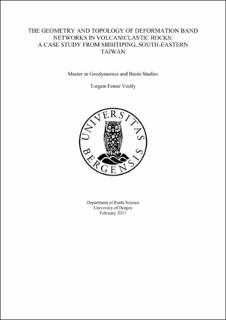| dc.description.abstract | Deformation bands are tabular strain localization features, common in porous and granular rocks. These structures of millimeter to centimeter thickness can occur as single bands and develop into clusters or networks of bands. Deformation bands have been extensively documented in siliciclastic rocks, whereas fewer studies address deformation bands in porous volcaniclastic rocks. In recent years, volcaniclastic reservoirs have become a hot topic in petroleum- and geothermal exploration, groundwater aquifers and CO2 storage. Deformation bands are generally associated with a permeability reduction from one to three orders of magnitude compared to the host rock and deformation band networks may affect subsurface fluid flow patterns. Knowing the network properties of deformation bands are therefore crucial when predicting their impact on fluid flow. This M.Sc. project quantifies clusters and networks of deformation bands in volcaniclastic rocks from Shihtiping, Eastern Taiwan. A thorough topological analysis of deformation band networks has been carried out, focusing on characterizing the distribution and connectivity of bands within a network. Individual deformation bands were analyzed based on their geometry, including length, density, and intensity, to access the spatial relationship of bands within the networks. The quantitative relation of nodes and branches provides the basis for describing the connectivity in the studied deformation band networks. The deformation band networks are generally dominated by connecting Y-nodes and fully connected (C-C) branches, resulting in high average connectivity. Furthermore, the topological characteristics can be associated with bifurcating, abutting, and splaying bands, and bands are less prone to crosscut one another. The highest connectivity is related to mature deformation band networks and deformation band networks in fully developed faults. This supports the theory that the connectivity of deformation networks develops with time and maturity (strain). The analyses of the deformation bands show that nodal distribution, intensity and connectivity are vulnerable to lithological heterogeneities across the network. This study strengthens our understanding of the development of deformation bands in volcaniclastic rocks and explores the evolution of connectivity in deformation band networks. Quantifying the topological and geometrical characteristics of deformation band networks is essential as it generates parameters used to assess the potential for fluid flow in a reservoir. | |
